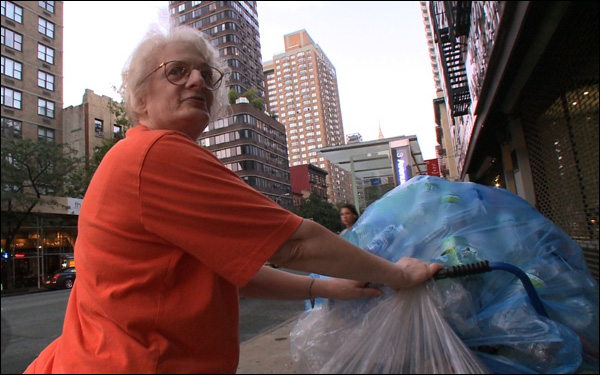Jon Alpert and Matthew O’Neill know all too well that sometimes the best documentary subjects can be hiding in plain sight, but in the case of their Oscar-nominated short “Redemption,” that’s also a sad truth about America at large. While the men and women profiled in the filmmakers’ latest work are some of the most prolific and distinctive members of society, they are also as forgotten about as the discarded recyclables they earn their living with, noticed for the unwieldy shopping carts they push, but rarely considered any further.
That is where Alpert and O’Neill do something special by giving seven such New Yorkers the spotlight, allowing them the chance to explain how they wound up going through others’ garbage to turn an honest buck. Their stories are surprising, but not in relation to each other, most resorting to canning after other jobs dried up. From Susan, a former marketing executive who was once considered to be among the 20 best at IBM in Gramercy Park to Nuve, a single mother with two kids in Queens who still believes she can give a better life to her children than the one she’s endured, the film draws upon the two-and-a-half years Alpert and O’Neill spent trawling the streets to offer up a fully fleshed out portrait of the gleaners.
In the run up to the Oscars, we gleaned a little of the backstory from the filmmakers about how this particular subject found them, the larger implications of what they learned while filming and why they really hope you’ll watch their competition for an Academy Award.
How did you get interested in this subject?
Jon Alpert: I think everybody in New York wonders about these people, but never talks to them and walks right by, especially because they’re ferreting around in the garbage. But Sheila Nevins, whose fertile mind is always bubbling, came downstairs early in the morning and there was somebody in her garbage. Across the street, there was another somebody in somebody else’s garbage and basically wherever she looked, she saw people doing this. We were talking about another film and she said, “Who are these people that are going through the garbage?” Would you guys like to find out about it? That’s how it started.
In recent years, you’ve spent plenty of time in the rest of the world. Was it interesting to go into your own backyard for this?
Matthew O’Neill: Many different, really good filmmakers have done films all around the world using a dump or a garbage place where people are gleaning as a way to illustrate the vast gulf between the rich and the poor in that other country. The disparity between the haves and have nots in New York City is really appalling and the men and women featured in the film are not looking for a handout. They’re not taking money from the government or from you or from me. They want to work. They have an incredible work ethic and there’s no way for them to make money right now other than glean through our garbage.
You do get that from the film that they’re very proud and self-sufficient. Was it a gradual process for you to earn their trust?
JA: We come from an interesting background. There’s no classical filmmaking training. Our training is all from the streets and where we come from, Downtown Community TV Center, is a community organization and the people who we work with every single day, who come in to take our classes and borrowing equipment from us aren’t the big Wall Street types. They are people like the folks that are featured in our documentary, so that part was easy. We weren’t aliens and we didn’t think they were aliens.
MO: We also immersed ourselves in the culture of canning for almost two-and-a-half years. We had a learning curve too. If you went up to someone on the street who’s collecting cans and say, “Excuse me, how much money do you make from canning?” They don’t want to talk to you. But Jon or I would go up to a canner on the street and say, “Hey, I see you have Heineken, the A & T over on Third street is actually accepting Heineken today,” because everybody knew that there are only a few places in the city that would accept Heineken bottles.
Did the country’s overall economic woes enter into thinking about how you might frame the film?
JA: Sometimes we’re not thinking about this when we start, but in the past few years, we’ve had two sets of movies. One set is about the consequences of the wars that we’re fighting. Before that, it was the consequences of drugs. We had “Life of Crime,” [where] we followed three drug addicts over a ten-year period. “High on Crack Street,” which is about Lowell, Massachusetts and what drugs do there, that’s the documentary that the movie “The Fighter” was based on. “The Latin Kings,” in which a working class hero, King Tone, who’s the head of the Latin Kings and who had the capacity to do really incredible good things for the Latino population in New York gets brought down by drugs. Then we did a series about the consequences of war with “Baghdad ER,” “Alive Day Memories,” “War Torn: Section 60.”
But we’re also doing something about work and we did a documentary, “Thunder Cars of Indiana” about Anderson, Indiana, a town of 70,000 people that had 30,000 General Motors jobs in its heyday. Now, it doesn’t have a single General Motors job there. We also did a documentary about the Stella D’oro cookie factory up in the Bronx, which is where people like our canners used to have jobs. They came off the boat and worked there and they raised their families, they had a good living. That factory is closed, all the jobs are gone. And in our neighborhood in Chinatown, all the surrounding buildings used to be garment factories. All those garment factories are shut down. So this is something that is happening in our city and it’s also unfortunately happening all across the country.
The film’s structure and some specific shots seem intended to contrast the grandeur of the skyscrapers with those scavenging on its streets. Was that initially something you were interested in or did that come about organically?
JA: At one point, we did start thinking about that because we were following our characters so closely that the film began to feel a little bit claustrophobic. We believe that actually the other character in the film is New York and these people are coming up with basically a coping strategy to stay in a city that’s sort of stomped on them. We wanted to be able to work it in, so we decided to go to the iconic locations of New York City and just stand in front of a garbage can and let’s see how long it takes for a canner to come by, then we’ll put all these things together.
In the documentary there is a Statue of Liberty, there’s the Empire State Building. In the outtakes, there’s the United Nations and a bunch of other places and you didn’t have to wait longer than five minutes in front of any of these symbols of New York before somebody came by and began looting through the garbage. It was another really sobering and chilling aspect of the production. There’s a James McMurtry song, “We Can’t Make It Here.” Unfortunately that’s what’s happening because almost everybody in our documentary had a job making something at one point and those opportunities are gone.
Well, I wish you the best of luck at the Oscars…
JA: This is the thing about the Oscars. The Oscars for documentary filmmakers are a chance to expand the conversation and the films that are fortunate enough to get as far as ours have and the one that wins are going to be able to get into more people’s homes.
MO: All the short subject documentaries, it’s a great testament to the way documentaries have ambitions to change the world and make it a better place. We all wrestle with really important topics that the world needs to know more about.
“Redemption” will air later this year on HBO, but can be seen theatrically through the Oscar Shorts Program currently circulating throughout the country. A full schedule can be found here.




